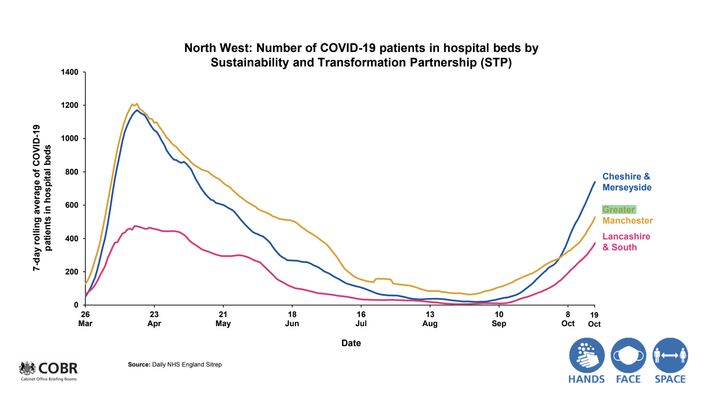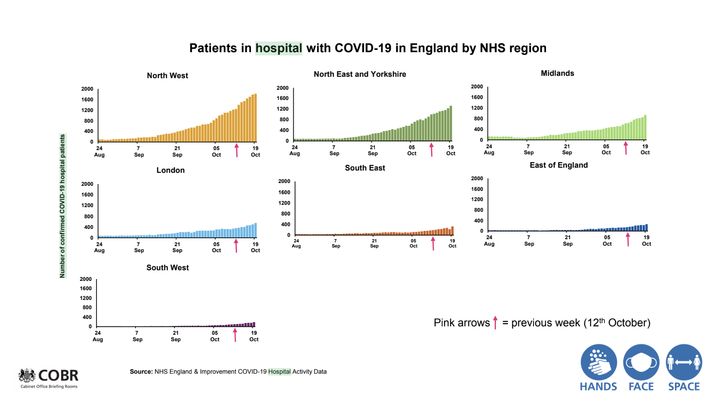After weeks of disagreement between local leaders and No.10, Greater Manchester will be put into a tier 3 lockdown at 12.01am on Friday.
Boris Johnson and Greater Manchester’s mayor Andy Burnham have been at loggerheads over the level of financial support offered to the conurbation to help it through the restrictions.
Burnham said local leaders had calculated the area needed £65m to prevent a “winter of real hardship”, but Downing Street has so far only confirmed it will receive £22m. Government figures, though, have signalled that a maximum figure of £60m may still be on the table.
How many cases and deaths have there been?
Manchester Evening News reported on Tuesday that 2,457 people had died in Greater Manchester’s hospitals since the start of the Covid-19 crisis.
In the most recent 24-hour period (ending 4pm on Monday), 22 deaths had been registered.
The most recent local data on cases and Covid triages (online or through 111/999) made available by the NHS ends on October 18. From October 12 to October 18 there were 11,489 new Covid-19 cases reported across the 10 local authorities in Manchester.
The Manchester Evening News also reported that more than 2,000 cases of the virus (2,162) were confirmed in Greater Manchester on Tuesday – only the third time cases in the population had surpassed 2,000 in a day since the start of the crisis.
The most recent NHS figures on infection rates, again from October 12 to October 18, show a rate of 405.2 per 100,000 people. Rochdale has the highest infection rate, at 475.2 per 100,000 people, while Stockport has the lowest at 281.2 per 100,000.
The full list is as follows:
- Rochdale – 475.2 per 100,000
- Salford – 469.8 per 100,000
- Oldham – 448.7 per 100,000
- Wigan – 440 per 100,000
- Bolton – 427.8 per 100,000
- Manchester – 418.2 per 100,000
- Bury – 407.4 per 100,000
- Tameside – 359.4 per 100,000
- Trafford – 314.7 per 100,000
- Stockport – 281.2 per 100,000
How full are the region’s hospitals?
Both Boris Johnson and health secretary Matt Hancock have warned that bed occupancy across the 12 hospitals in Greater Manchester is high, with hospitalisations from the virus rising so rapidly that they could run out of intensive care unit (ICU) beds by November 12.
But Burnham has insisted the government is using “selective statistics” – telling Andrew Marr on Sunday that Johnson had overstated the infection rate in the region and their impact on hospitals.
There is no clear data on hospital bed occupancy in Greater Manchester. The last NHS release about the number of Covid cases at UK hospitals ends on October 11 (a newer version comes out on Thursday, up to October 18) and the only data for intensive care beds is published monthly – the next one is due on November 12.
From these, we can learn that 96 Covid patients were admitted to, or diagnosed at, Manchester University NHS Foundation Trust in the seven days up to October 11, the fifth highest number in the country – behind trusts in Birmingham, Nottingham, Leeds and Blackpool.
There were 95 admitted to, or diagnosed at, the Pennine Acute Hospitals NHS Trust; 42 in Stockport; 39 in Salford Royal; 33 in Tameside and Glossop; 59 in Wrightington, Wigan and Leigh; and 42 to Bolton NHS Foundation Trust. But these figures are 10 days old.
The Guardian reported that Burnham had published several charts showing how many beds, including ICU beds, are being used by Covid-19 patients in Greater Manchester – but these are not broken down by hospital. The most recent charts suggested there were 415 in hospital and 55 in ICU on October 13.
Days later a leaked NHS England document seen by The Guardian appeared to show there were 257 total ICU beds across Greater Manchester’s hospitals as of October 16, with 211 in use by both Covid and non-Covid patients – an occupancy rate of 82%.
Burnham said on Sunday that there were “around 62” Covid patients in ICU, but the leaked document said the figure was between 90 and 110. According to The Guardian, this disparity is likely down to Burnham referring only to confirmed cases, while the NHS list confirmed and suspected cases in the same category.
The Manchester Evening News has pressed the issue of ICU capacity extensively, with one reporter spending a full day on Monday trying to access trust-by-trust Covid admissions numbers as a proportion of overall capacity, compared to the April peak, as well as the same figures for intensive care and high dependency beds.
Despite contacting every hospital trust in Greater Manchester, as well as five other bodies including the Department of Health and Social Care (DHSC), Downing Street and the mayor’s office, not a single organisation responded with answers.
Most of the little information regularly published on bed occupancy only breaks the figures down by region, with the north-west presented unhelpfully as one homogenous area – which does nothing to explain what is going on in Greater Manchester.
On Tuesday No.10 did send out the slides used by the PM during his press conference announcing restrictions in Greater Manchester, showing the seven-day rolling average of Covid-10 patients in hospital beds in the conurbation edging towards 600 as of October 19.
These figures are across all hospital beds, and don’t refer specifically to ICU capacity – and also show that the number of hospitalised patients is still roughly half of what it was at the peak of the first wave in mid-April.

What about other badly-affected areas in England?
As explained above, the NHS only puts out regional data on hospital capacity, meaning it’s very difficult to gauge how health services are coping from one specific area to the next.
The most recent charts issued on a regional basis, shown in the PM’s press conference, reveal that the north-west as a whole has a significantly higher bed occupancy rate for patients with Covid than the rest of England, followed most closely by the north-east and Yorkshire. The north-west, of course, also includes the Liverpool City Region that was the first place in England to go into tier 3.

Four regions of England – Liverpool City Region, Lancashire, Greater Manchester and South Yorkshire – are now under tier 3 restrictions, but as infection rates remain high talks are ongoing to put other areas under tougher rules.
Nottinghamshire currently has the highest infection rate in the country, with 2,237 new cases recorded in the seven days to October 16 – the equivalent of 672.0 cases per 100,000 people.
The PM announced during his press conference on Tuesday that leaders in Nottinghamshire were involved in talks about heading into tier 3 restrictions.
According to Yorkshire Live, eight areas of Yorkshire are currently higher than some areas of Greater Manchester in tier 3 lockdown. Sheffield – which went into tier 3 on Wednesday morning – is the highest of these with an infection rate of 406.1 per 100,000 people.
Barnsley, Leeds, Bradford and Rotherham also have higher infection rates than areas now under tier 3 restrictions.

